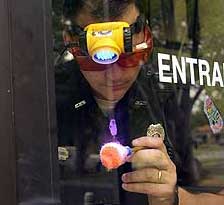Fingerprint detection
An innovative tool for fingerprint detection developed by a researcher at the Savannah River National Laboratory is now available commercially.
An innovative tool developed by a researcher at the Savannah River National Laboratory (SRNL) to give law enforcement personnel a method for on-the-scene fingerprint detection and analysis has been issued a patent by the US Patent and Trademark Office.
The BritePrint device, invented by SRNL’s Eliel Villa-Aleman is a small, lightweight, battery-powered, high-intensity light source that saves investigators valuable time in the investigation process.
The typical method for detecting fingerprints is a slow, cumbersome operation, in which personnel hold a heavy light source – sometimes for hours at a time – while using tape to lift prints, then send the tape back to a laboratory for analysis.

The lightweight BritePrint device would typically be worn on a headset for hands-free operation. Its light emitting diodes (LEDs) produce light that causes areas brushed with dye to be visibly fluorescent.
Wearing light-filtering goggles makes markings in these areas easily detectable by the human eye, allowing an analyst to quickly proceed with on-site identification and analysis of prints. It can also be used with a video camera for recording critical crime scene evidence.
Register now to continue reading
Thanks for visiting The Engineer. You’ve now reached your monthly limit of news stories. Register for free to unlock unlimited access to all of our news coverage, as well as premium content including opinion, in-depth features and special reports.
Benefits of registering
-
In-depth insights and coverage of key emerging trends
-
Unrestricted access to special reports throughout the year
-
Daily technology news delivered straight to your inbox










Comment: Engineers must adapt to AI or fall behind
A fascinating piece and nice to see a broad discussion beyond GenAI and the hype bandwagon. AI (all flavours) like many things invented or used by...